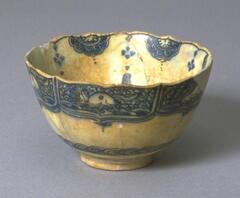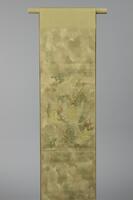29 UMMA Objects
29 UMMA Objects
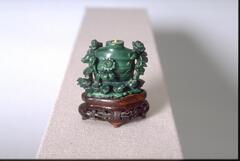
Chinese (Chinese (culture or style))
Malachite ornamental snuff bottle
1912 – 1949
Gift of Mr. Robert W. Coggan
1980/2.42
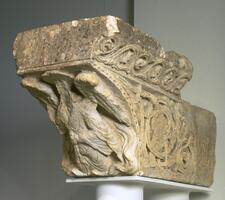
French (French (culture or style))
Console with bird in vine scroll, rinceau, and angel
1150 – 1175
Museum Purchase
1975/1.64

Chinese (Chinese (culture or style))
Jasper snuff bottle
1912 – 1949
Gift of Mr. Robert W. Coggan
1980/2.25
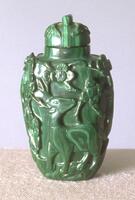
Chinese (Chinese (culture or style))
Malachite snuff bottle
1912 – 1949
Gift of Mr. Robert W. Coggan
1980/2.50
![This is a grayish brown small jar with a short neck and a globular body. It is dated to the end of the 19th century, judging from its motifs, color of cobalt-blue and shape. It is decorated with a line around the rim and with floral scrolls on the shoulder. The entire foot is glazed and has grains of coarse sand stuck to it. Extensive contamination from impurities on its surface has given it a yellow tint overall.<br />
[Korean Collection, University of Michigan Museum of Art (2014) p.174] This is a grayish brown small jar with a short neck and a globular body. It is dated to the end of the 19th century, judging from its motifs, color of cobalt-blue and shape. It is decorated with a line around the rim and with floral scrolls on the shoulder. The entire foot is glazed and has grains of coarse sand stuck to it. Extensive contamination from impurities on its surface has given it a yellow tint overall.<br />
[Korean Collection, University of Michigan Museum of Art (2014) p.174]](/media/W1siZiIsIjIwMjIvMDkvMjQvN29kYzJkdGp4d19kZWZhdWx0LmpwZyJdLFsicCIsInRodW1iIiwiMjQweDIwMCJdXQ?sha=603bd4d6c7b5b184)
Korean (Korean (culture or style))
Small Blue-and-White Jar with Bamboo Design, misfired
19th century
Gift of Bruce and Inta Hasenkamp and Museum purchase made possible by Elder and Mrs. Sang-Yong Nam
2004/1.277

Chinese (Chinese (culture or style))
Snuff bottle with blue floral sprays under green glaze
1912 – 1949
Gift of Mr. Robert W. Coggan
1980/2.111

Chinese (Chinese (culture or style))
Agate snuff bottle
1900 – 1949
Gift of Mr. Robert W. Coggan
1980/2.18
![A glazed porcelain jar, whose body is wide and round with a lipped, wide opening. Detailed with a Korean character, possibly a label for the jar's contents, in blue.<br />
<br />
This voluminous jar is decorated with simplified foliage designs on the body in underglaze cobalt blue in two places. Glaze has been wiped away from the rim and the foot rim. The body features a crack and several black spots. It is made from the kaolinite-rich clay which formed thin and light walls.<br />
[Korean Collection, University of Michigan Museum of Art (2014) p.175] A glazed porcelain jar, whose body is wide and round with a lipped, wide opening. Detailed with a Korean character, possibly a label for the jar's contents, in blue.<br />
<br />
This voluminous jar is decorated with simplified foliage designs on the body in underglaze cobalt blue in two places. Glaze has been wiped away from the rim and the foot rim. The body features a crack and several black spots. It is made from the kaolinite-rich clay which formed thin and light walls.<br />
[Korean Collection, University of Michigan Museum of Art (2014) p.175]](/media/W1siZiIsIjIwMjIvMDkvMjQvMnpkYzRnNjR0b19kZWZhdWx0LmpwZyJdLFsicCIsInRodW1iIiwiMjQweDIwMCJdXQ?sha=43286691dcdebf00)
Korean (Korean (culture or style))
Porcelain Jar
1900 – 1950
Gift of Ok Ja Chang and the Chang Family
2009/2.67
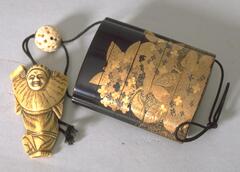
Japanese (Japanese (culture or style))
Inro (four-case medicine box), ojime, and netsuke of Hanshan?
19th century
Transfer from the College of Architecture and Design
1972/2.103
Loading…
